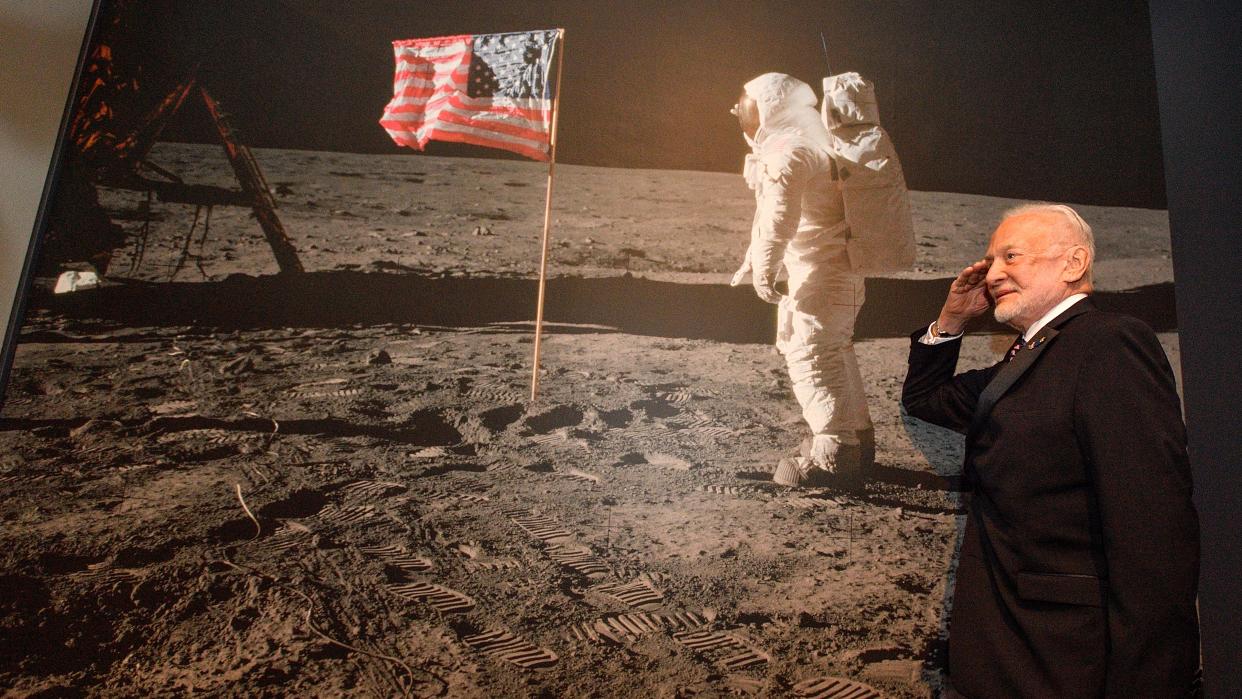NASA's Artemis moon program receives salute from Apollo 11's Buzz Aldrin (video)

- Oops!Something went wrong.Please try again later.
The second person to walk on the moon can't wait to see new astronauts follow in his footprints.
Buzz Aldrin, one of the astronauts of the Apollo 11 mission of 1969, said Thursday (Feb. 23) he is excited to see NASA land people on the moon again as soon as 2025 with its Artemis program.
A livestreamed pre-recorded video with comments by Aldrin, 93, played at a meeting of the users' advisory group of the National Space Council (NSpC) in Washington, D.C. on Thursday (Feb. 23). US Vice-President Kamala Harris leads the council and the role of the users' advisory group is to allow a space for industry, non-profit and other sectors to give guidance on space policy.
"We salute the young men and women, astronauts, scientists, and technicians who are now picking up the torch of deep space exploration," said Aldrin, adding that he tuned into all events of the "inspiring" uncrewed Artemis 1 test launch that flew a human-rated Orion spacecraft around the moon and back in late 2022.
Related: Apollo 11 at 50: A complete guide to the historic moon landing

Alluding to the events surrounding Apollo 11's mission between July 16 and July 24, 1969, Aldrin said he had the "extraordinary privilege to have played a role in one of the epic dramas of our age: America's race to the moon and back."
At the time, space was seen as a proving ground for technology, with military potential. Both the United States and the Soviet Union sent a series of missions to show that space could be used by humans for exploration, Earth observation and science as well.
An element of international prestige was involved, too; some observers frame the two countries' activities as a "Space Race", although there were times when the Americans and Soviets were considering collaborative missions in the 1960s. (The first such mission took place in 1975 with the Apollo-Soyuz Test Project.)
Russia, the successor entity to the Soviet Union, is now a partner on the International Space Station. But most other collaborations were torn asunder a year ago, on Feb. 24, 2022, with Russia's internationally condemned invasion of Ukraine.
Related stories:
—Apollo 11: First men on the moon
—Apollo 11 at 50: A complete guide to the historic moon landing
—Apollo 11 was a voyage of discovery about our solar system
Aldrin maintained that his crew's intentions were meant to be first steps to bringing people of all nations to the moon, which is also an aim of Artemis. "We planted the American flag on the moon," he acknowledged, which all Apollo crews did. "[But] we did so not to lay an imperial claim to the moon as idealistic Americans; we came in peace for all mankind."
No crews have been named for upcoming Artemis missions, but news should be coming shortly. Artemis 2, which aims to circle the moon in 2024, will announce its crew this spring — including a Canadian, thanks to the country's Canadarm3 robotic contribution to a planned NASA space station called Gateway. Artemis 3 will then aim for the surface in 2025. Japan is rumored as well to be a contender for early missions, based on comments about its astronauts joining Artemis.
Aldrin is the only surviving member of the Apollo 11 crew. Commander and first-ever moonwalker Neil Armstrong died in 2012 at age 82 while command module pilot Michael Collins died in 2021 at age 90.
Apollo 11 was the second space excursion for Aldrin. His first mission was the Earth-orbiting Gemini 12 mission in 1966, performing three short spacewalks while extra-vehicular activities were still in their infancy.
Elizabeth Howell is the co-author of "Why Am I Taller?" (ECW Press, 2022; with Canadian astronaut Dave Williams), a book about space medicine. Follow her on Twitter @howellspace. Follow us on Twitter @Spacedotcom or Facebook.

